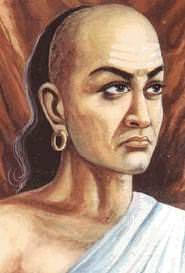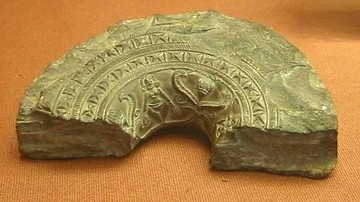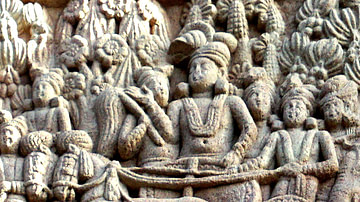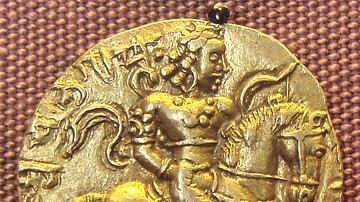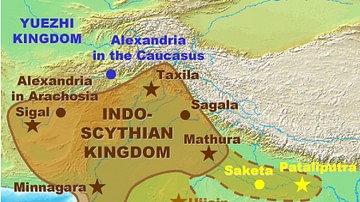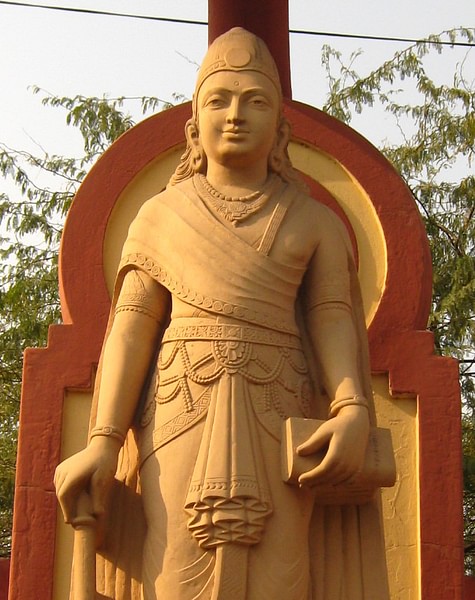
Chandragupta Maurya (c. 321 - c. 297 BCE), known as Sandrakottos (or Sandrokottos) to the Greeks, was the founder of the Maurya Dynasty (4th-2nd century BCE) and is credited with the setting up of the first (nearly) pan-Indian empire. Aided by his mentor and later minister Chanakya or Kautilya (c. 4th century BCE), he set up a vast centralized empire, details of whose functioning, society, military, and economy are well preserved in Kautilya's Arthashastra.
Chandragupta's Period: Political Setting
India around the 4th century BCE was divided into numerous kingdoms and republics. The foremost among them was the Magadha Kingdom in eastern India, whose rulers beginning with King Bimbisara (543-492 BCE) had embarked on a quest for empire-building. Magadha's boundaries had thus been much extended over time and contained a good part of central, eastern, and north-eastern India. Alexander the Great (356-323 BCE) invaded India in 326 BCE, and in consequence, much of north-western India was thrown into turmoil and political chaos.
The Magadha ruler during these times was Dhanananda (329-322/321 BCE) of the Nanda Dynasty. He possessed a vast treasure and an army numbering 20,000 cavalry, 200,000 infantry, 2,000 chariots, and 3,000 elephants, according to the Roman historian Curtius (c. 1st century CE). Known to the Greeks as Xandrames or Agrammes, the knowledge of his Magadhan might had also added to the despair of the already war-weary Macedonian troops on India's north-west, forcing them, among other reasons, not to press further into India.
Debate on Origins
Much of Chandragupta's life and origins are still shrouded in mystery. Most of what is known about him comes more from legends and folklore rather than actual historical sources; “The only definite inscriptional reference to Chandragupta is in the 2nd century CE Junagarh inscription…” (Singh, 330.) Historian KAN Sastri observes:
For details of the momentous events that led to the supersession of the Nandas by the Mauryas we must turn to Indian chroniclers and story-tellers. No contemporary account has survived. The traditional story is told differently by different writers. (Sastri, 145).
Chandragupta's social origins, particularly his caste, are still debated. Buddhist, Jain, and ancient literary works all give different versions. He is mentioned variously as belonging to the Kshatriya Moriya clan ruling Pippalivahana on the present-day Indo-Nepal border, as being from a tribe of peacock-tamers, a son of a woman named Mura (hence the title, Maurya) and even closely or distantly related to the Nandas, but scorned and driven away as Dhanananda was jealous of his far-superior talents.
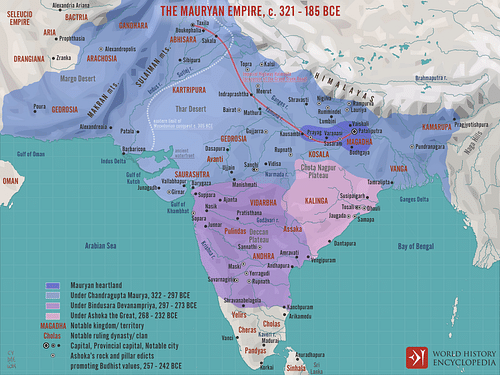
Historians are thus divided as to his social origins. Some claim that “he seems to have belonged to some ordinary family” (Sharma, 99) and that “he was not a prince but a mere commoner without any direct title to the crown of Magadha” (Tripathi, 146). Some other historians state that he indeed belonged to the Moriya or Maurya clan, which by the 4th century BCE had fallen into hard times, and thus Chandragupta “grew up among peacock-tamers, herdsmen, and hunters” (Majumdar, Raychaudhuri and Datta, 92). The Roman historian Justin (c. 2nd century CE) alludes to his humble origins. Buddhist texts and medieval inscriptions mention him as a Kshatriya. Thus, it can be conjectured that he would have belonged to a Kshatriya (ruler/warrior caste) or a related caste, as the Brahmin Kautilya, in keeping with the caste rules, would not have favoured him otherwise for rulership.
Chandragupta was ambitious and sought ways and means of attaining a position of authority or even a crown. This desire could have easily been born because of his circumstances. He wanted to restore his clan's fallen fortunes and establish himself in his rightful position as a Kshatriya ruler. Even if the version about him being related to Dhanananda is accepted instead, then such an intention would have surely taken root in Chandragupta's mind and he would have wanted his fair share of being a prince. Even if from a completely ordinary family, Chandragupta did not feel his origins had anything to do with his political ambitions. Either way, historically, it is thus very probable that Chandragupta as a young man had definitely involved himself in the endeavour of fulfilling his ambitions.
Early Career
Chandragupta knew that to successfully accomplish his journey to power, war with the established kingdoms would be unavoidable. He thus focused on obtaining military training and experience. Legends say that he met Alexander and perhaps obtained his permission to serve in his army so as to learn the Macedonian way of warfare and how it could be used against the tactics of ancient Indian warfare, besides his own military training. Justin and the Graeco-Roman historian Plutarch (c. 46-120 CE) mention the meeting with Alexander. However, this meeting was a disaster, and Chandragupta was forced to flee for his life.
Some historians are of the view that for Chandragupta, who lived in the Magadhan kingdom, it was not possible to go all the way to the north-west to meet Alexander, even if the idea occurred at all to him in the first place. Instead, he met Dhanananda and sought service in his army. They believe that Justin mistakenly mentioned Alexander instead of Dhanananda. Such a view is however not accepted by all historians.
Irrespective of what Chandragupta's early moves in his career were, what can be stated with certainty is his relationship with the statesman-philosopher Kautilya. He was his best ally, mentor, and guide, and the one who shaped not only his career but the course of the Mauryan empire under Chandragupta. Vishnugupta Chanakya or Kautilya, on his part, had decided to take the leading role in rebuilding and reshaping the Indian polity. Though initially from Magadha, being a student and later a teacher at Takshashila (now Taxila in present-day Pakistan), Kautilya thus became witness to the political turmoil created in north-western India because of the Macedonian invasion. This caused him to think in terms of establishing a centralized pan-Indian empire that could keep invaders at bay and restore order. The existence of numerous republics and kingdoms, disunited and perennially at war with each other, for obvious reasons, could not do so.
He considered Magadha apt to be the empire in question - his proposal for the same was met by scorn and insults from Dhanananda, which was followed by Kautilya's determination to remove the incumbent king. Magadha was the only territorial entity that could provide order among the chaos. It had a virtually unrivalled military standing, crucial for the existence of the kind of empire that Kautilya wanted. Protected by its vast military, it enjoyed a stability that other kingdoms could not. Kautilya was thus determined to have Magadha as the centrepiece of his scheme of things - whether under the Nandas or someone else, it did not matter.
He thus decided to replace Dhanananda with a better and more capable candidate. The man chosen was Chandragupta Maurya. Mentoring him for the role, Kautilya prepared for a takeover of Magadha and all that went with it. Chandragupta's own calibre was thus honed in terms of war, diplomacy, and covert operations.
How and when his first meeting with Chandragupta took place are facts not clearly known. Folklore has it that after returning from Dhanananda's court, the humiliated Kautilya while plotting his revenge came across a boy in a village who even in a game was displaying qualities of being a great king. Quick to realise his potential, Kautilya decided to take him on as his protégé and sought the tribal or village chief's and the boy's mother Mura's permission to take him along and train him for his future role. He then brought the boy Chandragupta along with him to north-west India, from where, the stories say, Chandragupta grew up under training from Kautilya and was thus prepared for his role as the future emperor.
In all likelihood, these stories cannot be accepted as fact as this would imply that by the time Chandragupta came to the throne of Magadha, both Kautilya and Dhanananda were decrepit old men! Historically this was not true, so as the historians maintain, the young man Chandragupta who was already seeking to make his fortune met and allied with Kautilya, whom he had realised as an invaluable ally. The importance of the stories, however, lies in the fact that they point towards Chandragupta's humble origins, his circumstances, and how they were not suitable for his growth, and thus he had to move out in order to attain his objectives.
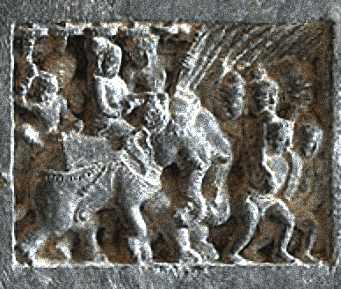
His meeting with Kautilya would have thus taken place after the humiliated scholar was returning from Pataliputra and Chandragupta's own initial endeavours to win power had been unsuccessful. Having realized that they had much in common, the two set out to achieve their common goals. The discovery of an underground treasure led them to recruit a mercenary army.
The War for Power
Using the post-Macedonian invasion area of north-west India as an ideal base because of its chaotic conditions and lack of political and military opposition, Chandragupta deployed his men, challenged the waning Greco-Macedonian authority and scored victories over the local kingdoms or whatever was left of them. He then gained control over central India and finally advanced towards the Magadha heartland.
Realizing that a conflict with Magadha would necessarily entail much more than a mighty army, Kautilya went for the war-by-other-means strategy. There were lots of intrigues, counter-intrigues, plotting and counter-plotting which he resorted to in order to break the strength of Dhanananda by weaning away his key allies, loyalists and supporters, most notably his chief minister Rakshasa. The Sanskrit drama Mudrarakshasa (“The Ring of Rakshasa”) written by Vishakhadatta somewhere between the 4th to 8th centuries CE (presumably 5th century CE) gives vivid details of the same. Ultimately, by employing both military and non-military means, Chandragupta managed to secure the throne at Pataliputra. Dhanananda probably escaped or was killed.
Indian Conquests
Secure in the imperial seat, Chandragupta directed his attention towards expanding his dominions. The Mauryan armies reached as far as the western coast of India and southern India, particularly the present-day state of Karnataka. Plutarch states that he overran the entire country with an army of 600,000. The Mauryan empire at this time included the present-day states of “Bihar and good portions of Orissa and Bengal but also western and north-western India, and the Deccan…in the north-west they held sway over certain areas which were not included even in the British empire” (Sharma, p. 99). The extreme south and north-east India were not part of the empire.
War with the Greeks
Chandragupta came into conflict with Seleucus I Nicator, Alexander's heir in the east, the idea being the reduction of the Greek power and gaining in own territory and strength. The war ended in 301 BCE by the signing of a treaty. Chandragupta obtained the areas of Arachosia (Kandahar area in present-day Afghanistan), Gedrosia (southern Baluchistan in present-day Pakistan) and Paropamisadai (the area between Afghanistan and the Indian subcontinent). 500 elephants were given to the Greeks. Legend maintains that Seleucus handed over his daughter Helena in marriage to Chandragupta but historical evidence does not support it. It was also decided to appoint a Greek ambassador and as a result, Megasthenes came to the Maurya court at Pataliputra. He wrote about the Mauryan administration and though his work Indica is now lost, quotations of it survive in the works of several subsequent Greek writers.
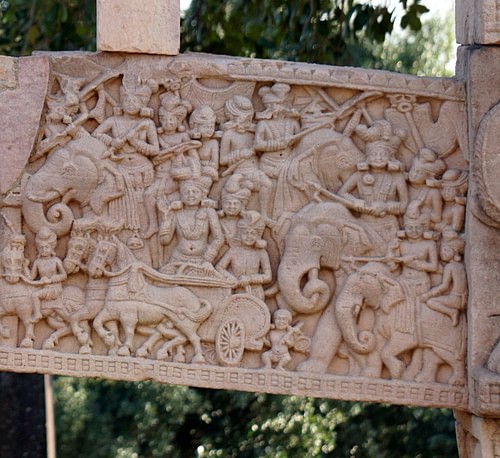
Jainism & Death
The Mudrarakshasa uses the Sanskrit term vrishala, employed for Kshatriyas and others who deviate from the Brahminical rules, to denote Chandragupta; “That Chandragupta did deviate from Brahminical orthodoxy is proved by his predilection shown for Jainism in his later years” (Majumdar, Raychaudhuri and Datta, p. 92). Both historical evidence and popular belief state that Chandragupta in his later years accepted Jainism. Inscriptions in Karnataka dating between 5th to 15th centuries CE mention a certain Chandragupta in connection with the Jaina saint Bhadrabahu. Chandragupta probably abdicated, became an ascetic, accompanied Bhadrabahu to Karnataka and later died by following the ritual of sallekhana, i.e., fasting till death. Chandragupta thus ruled for 24 years and was succeeded by his son Bindusara (297- c. 273 BCE), father of Ashoka the Great (268-232 BCE).
The Mauryan Empire under Chandragupta
Mauryan Government
Chandragupta developed an elaborate system of imperial administration. Most of the power was concentrated in his hands, and he was assisted in his duties by a council of ministers. The empire was divided into provinces and had princes as viceroys. This provided the royals with the requisite administrative experience, especially the one who went on to become emperor. The provinces were divided into smaller units and arrangements were put in place for both urban and rural administration. Archaeological evidence of the existence of a number of towns and cities has been found. Of these, the most prominent was the capital city of Pataliputra. Its administration was carried out by six committees with five members apiece. Some of the tasks entrusted to them included the maintenance of sanitation facilities, care of foreigners, birth and death registration, regulation of weights and measures, etc. Various types of weights used in this period have been discovered in several places. The central government also maintained about two dozen departments looking after various social and economic activities.
Mauryan Military
The state possessed a huge army. Troops (maula) were recruited, trained, and equipped by the state. There were many communities and forest tribes (atavika) that were known for their military skills and prized as such. Mercenaries (bhrita) also existed in large numbers as did corporate guilds of soldiers (shreni) and they were recruited whenever required. The army was composed of four arms (chaturanga) - infantry, cavalry, chariots and elephants. There was a 30-member war office made up of six boards that looked after these various arms and also the navy and transport. According to the Roman writer Pliny (23 – 79 CE), Chandragupta possessed 600,000 infantry, 30,000 cavalry, and 9,000 elephants. The chariots were estimated at 8,000. They were all deployed in the field of battle in formation (vyuha), as decided by the commanders, based on factors such as the nature of the terrain and the composition of one's and one's enemy's forces. Great concern was shown to the training of men and animals. The king and princes were well-trained in the arts of war and leadership. They were expected to display courage and they often personally led their armies and participated in the defence of forts. The navy created by Chandragupta mostly performed coast guard functions and guarded the empire's vast trade being carried on the waterways.
Arms included bows and arrows, swords, double-handed broadswords, oval, rectangular or bell-shaped shields (often of hides), javelins, lances, axes, pikes, clubs and maces. Soldiers were either generally bare to the waist or wore quilted cotton jackets. They also wore thickly coiled turbans, often secured with scarfs tied below the chin, and bands of cloth tied across their waists and chests as protective armour. Tunics were worn during winters. The lower garment was a loose cloth worn as a kilt or in the drawer style (one end of the garment drawn between the legs and tucked in the waist at the back).
The Mauryans' vast military was supported by the vast size of the empire and the resources that thus came under its control. The state virtually controlled all economic activities and hence was able to command a large revenue and an abundance of financial resources.
Chandragupta thus left behind a legacy that has survived in the pages of the Arthashastra. Not only did he build up an empire by his own efforts, overcoming all obstacles, but he also set up sound principles for its governance and himself worked tirelessly for its growth. It was these achievements that make him one of ancient India's foremost rulers and the near-mythical figure of folklore.
